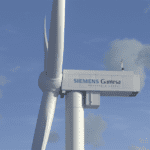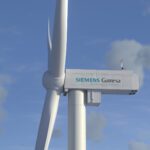Siemens Gamesa chief executive Jochen Eickholt acknowledged equipment failures in both the company’s onshore and offshore wind turbines, leading to higher warranty provisions, contributed to a nearly $1 billion net loss for the company in the last three months of 2022.
Eickholt on Feb. 2 said the company’s October to December—the group’s fiscal first quarter—loss increased to 884 million euros (about $970 million), compared with a loss of €403 million ($441 million) a year earlier.
The company in its latest earnings report said revenue was 9.8% higher year-over-year, reaching €2.0 billion ($2.2 billion). Net financial debt was €1.9 billion ($2.1 billion) at the end of 2022.
There was some good news from the group on Thursday, as Eickholt said Siemens Gamesa will reopen two U.S-based manufacturing facilities with the expectation of an uptick in U.S. demand for wind power equipment.
Siemens Gamesa, which is soon to be delisted and incorporated into parent Siemens Energy, said its first-quarter performance was impacted by what it called faulty components and service problems. “The negative development in our service business underscores that we have much work ahead of us to stabilize our business and return to profitability,” said Eickholt, who joined Siemens Gamesa from Siemens Energy last year.
Imminent Delisting
Shareholders of Siemens Gamesa last week approved plans for the company to be delisted from Spain’s securities market. The delisting from the National Securities Market Commission is expected this month.
Christian Bruch, who heads Siemens Energy, at the time of the recent delisting vote by shareholders said the European wind industry is at a critical stage. “Despite big investments flowing into renewables, the wind industry is facing serious financial challenges. Siemens Gamesa has presented the Mistral strategy program to get back on track, and the company needs now to implement it rigorously,” Bruch said. “The delisting will support the leadership team to focus entirely on the all-important financial turnaround. Concurrently, we have been discussing with regulators, policymakers, and our customers at all levels the requirements that are needed to make the strategically important wind industry successful.”
Eickholt as CEO has been tasked with fixing Siemens Gamesa’s operational issues. Those include problems with the company’s 5.X model onshore turbine that since its launch in 2019 has been noted in profit warnings for Siemens Gamesa and Siemens Energy. Richard Luijendijk, CEO of the company’s onshore business, last week said the 5.X has reached 5 GW in sales, and said a short-term goal of the company’s Mistral program is product maturity for the 5.X platform.
“The 5.X may have had a bumpy start, but there are now over 150 units installed, and there will be approaching 1,000 once we reach 5 GW of installations,” said Clark MacFarlane, the company’s onshore CEO for Northern Europe and the Middle East. “We have learned a lot from these first turbines, can see them technically mature and are confident that this is the right product for our customers.”
Outlook Good for Global Market
The company on Thursday said the outlook for the global wind power industry remains good, noting both the U.S. Inflation Reduction Act (IRA), and the RePowerEU program in Europe, should bolster renewable energy development. Siemens Gamesa in Thursday’s report also said that “further governmental action is needed to close the gap between ambitious targets and actual installations.”
Eickholt, speaking with analysts after Thursday’s earnings report, said the two U.S.-based manufacturing plants will be restarted as the company expects an increase in U.S. wind power activity after passage of the IRA. The plants include a blade manufacturing facility in Iowa, and a nacelle assembly plant in Kansas.
“In this context we already have taken the decision that the hibernation of our two manufacturing plants in the U.S., that this decision is reversed,” Eickholt said. “We’re about to reopen those factories earlier than anticipated because we see stronger demand in the U.S.”
—Darrell Proctor is a senior associate editor for POWER (@POWERmagazine).









